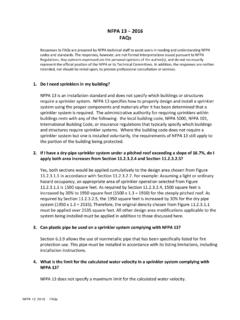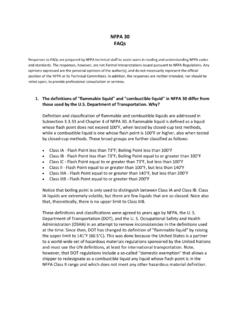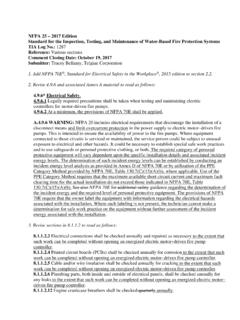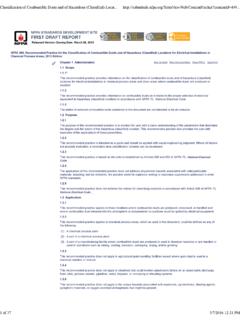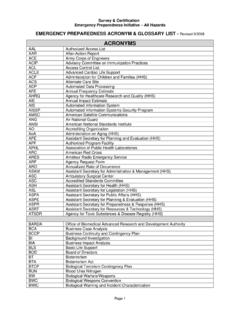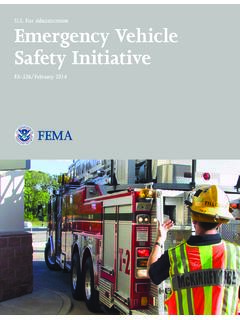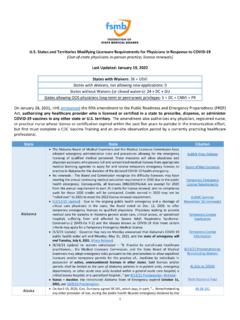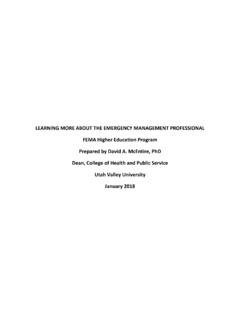Transcription of Fire and Emergency Service Personnel Knowledge and Skills ...
1 2019 Fire Protection Research Foundation 1 Batterymarch Park, Quincy, MA 02169-7417, USA Email: | Web: Fire and Emergency Service Personnel Knowledge and Skills Proficiency FINAL REPORT BY: Jamie McAllister, , , Brian McAllister, FireTox, LLC., New Market, Maryland, USA. September 2019 Page ii ---page intentionally left blank--- Page iii FOREWORD With a few local exceptions, certification of fire and Emergency services Personnel is conducted on a voluntary basis by public sector or government agencies. Present NFPA Professional Qualification System Standards, upon which are based the international certification systems ( , accredited by the Pro Board ), do not contain a requirement for maintaining proficiency on a stated interval.
2 Due to the criticality of credentialing of Emergency services Personnel and the fact that the Standards upon which certification is based change on a regular basis, there is a need to determine if fire and Emergency services Personnel need and/or should be required to undergo some other process to demonstrate continued Knowledge and Skills proficiency on a stated interval so as to maintain the proficiency. The goal of this research project is to identify, clarify and evaluate the characteristics of a transitional process for Fire and Emergency Services Personnel , designed to ensure continued demonstration of Knowledge and skill proficiency against a given level of credentialing, including an impact assessment of implementation. The Fire Protection Research Foundation expresses gratitude to the report authors Dr.
3 Jamie McAllister and Brian McAllister who are with FireTox, LLC., located in New Market, Maryland, USA. The Research Foundation appreciates the guidance provided by the project technical panelists, and the funding provided by the project sponsors. The content, opinions and conclusions contained in this report are solely those of the authors and do not necessarily represent the views of the Fire Protection Research Foundation, NFPA, Technical Panel or Sponsors. The Foundation makes no guaranty or warranty as to the accuracy or completeness of any information published herein. About the Fire Protection Research Foundation The Fire Protection Research Foundation plans, manages, and communicates research on a broad range of fire safety issues in collaboration with scientists and laboratories around the world.
4 The Foundation is an affiliate of NFPA. About the National Fire Protection Association (NFPA) Founded in 1896, NFPA is a global, nonprofit organization devoted to eliminating death, injury, property and economic loss due to fire, electrical and related hazards. The association delivers information and Knowledge through more than 300 consensus codes and standards, research, training, education, outreach and advocacy; and by partnering with others who share an interest in furthering the NFPA mission. All NFPA codes and standards can be viewed online for free. NFPA's membership totals more than 65,000 individuals around the world. Page iv Keywords: professional qualifications, firefighter, fire officer, fire chief, Knowledge , certification, competency, continuing education, Skills maintenance, proficiency, recertification.
5 Report number: FPRF-2019-19 FPRF Project Manager: Sreenivasan Ranganathan and Casey Grant. Page v PROJECT TECHNICAL PANEL Angela White, IFSAC & Wisconsin Technical College System Anthony O Neill, Pro Board (Primary) Brian Brauer, University of Illinois Fire Service Institute Debbie Sobotka, Center for Public Safety Excellence Fred Piechota, Pro Board (Alternate) Robert Fash, NFPA William Peterson, NFPA Pro Qual Correlating Committee Chair PROJECT SPONSORS Principal sponsor: National Fire Protection Association Participating Sponsor: The Pro Board Jim Shannon Leadership Fund to the Fire Protection Research Foundation Page vi ---page intentionally left blank--- Page vii EXECUTIVE SUMMARY The purpose of this research was to evaluate the current approaches utilized in the fire Service for proficiency training and continuing education.
6 Approaches utilized by parallel professions , Emergency medical providers, nurses, law enforcement officers, and teachers, were also assessed. Based upon these findings, a CE model was developed, and stakeholders were surveyed to determine how implementation of this CE model would impact them and their organization. The current editions of the NFPA Pro-Qual standards require fire Service members to remain current with the Knowledge and Skills related to their certification. This need for Knowledge and Skills proficiency has been expressed in various ways in the NFPA Pro-Qual and Training standards for at least a decade. Advancements in fire science reveal that continuing education in the fire Service goes beyond maintenance of initial Skills and core competencies.
7 Continuing education is necessary to ensure that firefighters are current with changes in suppression and ventilation techniques, building construction, fire behavior, personal protective equipment, firefighter health and safety, and more. The study found that every State and all the Canadian Provinces have at least one Pro Board or IFSAC Accredited Agency, however only 20 States (and no Canadian Provinces) have a continuing education program for recurrent training, recertification, or license renewal. These continuing education programs, along with the NFPA standards, most commonly required recurrent training on an annual basis. Considering all the professions and average hourly requirements, a 24 hour per year certification renewal model was recommended for firefighters.
8 The continuing education program would include a minimum of one live fire training per year, as well as methods to evaluate all associated job performance requirements. A variety of methods could be used to support completion of continuing education requirements including face-to-face and online training. Considering all stakeholders, the survey showed that the impact of this renewal model would be positive to very positive apart from the impact on completion of existing continuing education requirements, which was found to be negative. Page viii Table of Contents Section 1: Introduction .. 1 Section 2: Research Objectives .. 1 Section 3: Methodology .. 2 Task 1- Literature review to clarify current landscape .. 2 Task 2- Literature review of parallel 4 Task 3- Implementation and Assessment.
9 4 Section 4: Analysis & Discussion .. 5 Task 1- Literature review to clarify current landscape .. 5 Historical Context .. 5 NFPA Pro-Qual Standards .. 5 NFPA Training Standards .. 8 Current Practice .. 10 Recommended Frequency for CE .. 10 States with CE 11 Jurisdictions with Accredited Certifying Entities .. 22 Value and Benefit .. 23 Incident 1- New York, New 24 Incident 2- Wilmington, Delaware .. 26 Incident 3- Hamilton, Ohio .. 27 Incident 4- Houston, Texas .. 28 Incident 5- Boston, Massachusetts .. 29 Changing 30 Task 2- Literature review of parallel 32 Web Research .. 32 Emergency medical Providers .. 32 Nurses .. 35 Law Enforcement Officers .. 38 Teachers .. 40 Parallel professions Survey .. 42 Page ix Survey Results- Emergency medical Providers, Nurses, Law Enforcement Officers, and Teachers.
10 43 Survey Results: Fire Service Members .. 49 Task 3- Implementation and Assessment .. 55 Frequency Requirements .. 55 Hourly Requirements .. 56 Model Recommendations .. 64 Impact Assessment .. 65 Survey Results- Impact Assessment .. 67 Other considerations .. 79 Section 5: Summary .. 80 Section 6: References .. 82 Page x List of Figures Figure 1: Map of NREMT initial certification requirements by State .. 33 Figure 2: Map of NRP initial certification requirements by State .. 33 Figure 3: Distribution of Parallel professions Respondents .. 43 Figure 4: Parallel professions - Respondent Jurisdiction Type.. 44 Figure 5: Parallel Profession Requirements to Maintain Knowledge and Skills Proficiency.. 45 Figure 6: Parallel professions Financial Support Methods for Continuing Education.. 46 Figure 7: Parallel professions Training Frequency.

